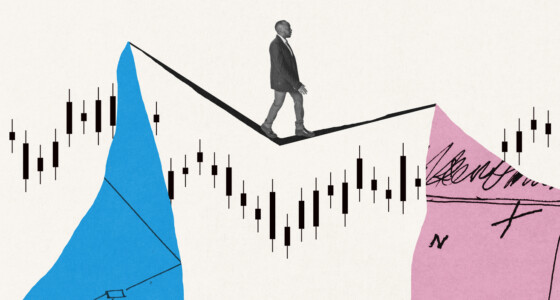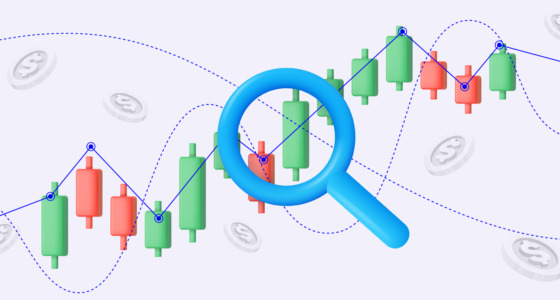

Do you want to check the direction in which the market trend is? Then the Volume trading strategy is for you. This article covers the terms associated with this strategy and how to use it.
What is the Volume trading strategy?
The Volume trading strategy revolves around the sole fact of analyzing the volume of stocks that are being traded in a particular market. The notion is to find the buying or selling pressure generated by the trading volume, ultimately guiding you toward trading decisions.
The price is what every trader looks for, but the trading volume determines profitability. It creates volatility and high-pitched moves in the market. These movements in markets such as stocks, bonds, and cryptocurrencies explain the shifting sentiments and how the price might move.
But before we analyze the Volume Trading Strategy, let us quickly understand its associated terms.
Trading volume
Trading volume measures the number of shares bought and sold in any particular financial instrument in a given period, usually a day. It is often used as a strong uptrend/downtrend signal. Remember, you should be looking for tick volume, not actual volume. You can also use volume indicators to analyze increased interest.
Trading volume can be different at other times. It might be higher near the opening and closing times of the market. However, it might be lower at lunchtime. Check the trend for this over some time.
Open interest
Open interest determines the total number of positions held in a market, whether short or long. This interest shows the likely trend the traders are moving towards. However, one must conduct a reality check before using this as an indicator.
There might be situations when the traders show extensive interest in particular stocks. However, it would be wise to see who is selling these. It might be a bank or a specific large broker, indicating a different picture.
Different types of Volumes
Various volume formats are available for analysis. All of them offer different but valuable information for trading. Below are a few important ones:
- Tick Volume refers to the number of transactions and not the total value of money. There might be a situation where the amount in terms of value is not much compared to the number of transactions. This might lead to lower profits even though there are many transactions.
- Dollar Volume refers to the total volume of money exchanged for all trades executed within a given period.
- Real Volume is the actual number of transactions or shares traded in the given time frame.
- Relative Volume compares the current volume level and the average volume level in a given period.
- On-Balance Volume (OBV) is a cumulative indicator that uses volume and price to ascertain a market’s buying and selling pressure.
Trading Volume for beginners
Many indicators can be used as a base for trading. However, remember that a few can be used as primary and others as secondary indicators. Volume Trading and Open Interest are rendered as momentum indicators. They help ascertain the strength and weaknesses of the market and not necessarily the direction of price action.
These are not recommended as the primary data mode for making trade decisions. Generally, they are considered unreliable market indicators in the short term unless used with other indicators.
In the long term or near future, they can assist in confirming the market’s direction. The Volume indicator is helpful in many situations and can lead to results if used sensibly in collaboration with other indicators.
In many situations, Open Interest and Volume are used together to give insight. For example, there might be a situation when the market has paused for some time, but the volume and the open interest are steady. There will be a better chance of considering that the market will resume continuing in the direction where it paused.
Volume and Open Interest are generally mentioned together for a very good reason. Whenever using them as market indicators, they are more reliable when both indicators are in agreement with each other. In a few situations, the combination of Volume and Open Interest may be considered reliable, like:
- When Volume and Open Interest move upwards, indicating an increase in the price or continuation of the current trend.
- The reverse is also true for both going down, suggesting a likely trend reversal or price fall.
When Volume and Open Interest move in opposite directions, then they should not be considered to be reliable indicators, like:
- When Volume is going up but Open Interest is going down, it may suggest a change in the market trend.
- On the contrary, Volume going down and Open Interest moving upwards suggest that the market is shifting momentum to move upwards. However, it can’t be relied upon unless confirmed by other reliable indicators.
Overall, it can be safely assumed that these are good indicators, but only when they are used efficiently with adequate signals.
Can Volume be used as a reversal indicator?
Yes, mostly when the market is at extreme ends in an upward and downward trend. A sudden jump in volume at extreme ranges suggests an interest in the price at this point. Volume can be a valuable indicator to help detect market reversals and significant changes in direction, up or down.

Advantages of Volume
Volume can be used to spot trends and identify patterns. A continuous increase in volume may indicate a strong bullish trend or the bearish trend in case of a decrease in volume. Volume precedes price action, which is our primary aim. As mentioned earlier, the volume helps make trade decisions but must always be backed by other indicators.
Some of the advantages accrued from the measurement of volume are:
- Trend Confirmation. An increase in price with a decrease in volume might suggest a lack of interest, indicating a likely reversal. At the same time, a fall or rise in price with a little volume is not a strong signal. A price fall (or rise) coupled with a large volume strongly indicates a likely significant change.
- Trend Weakness. In a rising or falling market, if the price movement is reaching exhaustion, but the volume does not support it, it could be an early sign of a weakening trend. Sharp price movements and a sharp increase in volume signal the potential end of the trend.
- Breakout Signs. Volume can help spot bullish signs. If, during the consolidation stage, volume breaks out like a wedge, triangle, or flag, then there is a likelihood of a sustainable breakout.
- False Breakouts. During a breakout, if there is only a slight volume change, it indicates a lack of interest. This might be an indication that it is a false breakout.
Accumulation/Distribution (AD)
Accumulation is a situation where the buyers are moving the market. It is indicated when the market is in a correcting mode, and yet the volume is increasing. For example, the volume would increase if the previous day’s closing price were high.
As the name suggests, distribution is a situation in which the sellers control the market. During an uptrend correction, an increase in the volume shows a reversal. If the volume has increased, even though the price has not shifted much, it might be due to the distribution effect.
An indicator named AD (Accumulation/Distribution) is also available on various trading platforms. The following formula is used to calculate this:
AD = ((Close – Open) / (High – Low)) x Volume
A negative indicator value suggests the distribution of the currency. A positive value, however, indicates accumulation.
Calculation of Volume
There are multiple options of indicators available to a trader today. The most frequently used indicators are:
Volume Indicator
It is the simplest and the most used indicator. It calculates the number of ticks in which a currency moves. There are other uses of this indicator, too, like in the case of AD. This indicator provides better signals for market trends.
On-Balance Volume
On-Balance Volume, or OBV, looks for stocks with increased volume without any significant price change. However, remember that the indicator is calculated by adding volume to the previous OBV value when the recent closing price exceeds the previous closing price. If the closing price is lower than the previous close, the volume is subtracted from the previous OBV.
Money Flow Index
The Money Flow Index, or MFI, is a momentum indicator. It measures money flow into and out of a security within a period. It acts as a technical oscillator incorporating price and volume data to identify overbought or oversold assets.
Market Facilitation Index
This indicator uses the volume in a formula that provides varied information. The formula used is:
MFI = (High – Low) / Volume
There are four combinations represented by color codes. B. William, who made this indicator, explains that in the following table.
| Color | MFI/Volume Level | Meaning |
| Blue | MFI Up/ Volume Down | Spikes |
| Pink | MFI Down/Volume Up | Start |
| Green | MFI Up/Volume Up | Trend Continuation |
| Brown | MFI Down/Volume Down | Trend End |
Note! The three key components which enable effective decision-making are Volume, Open interest, and Price action.
What is the best Volume indicator?
Several indicators use volume in one form or the other. But the one we suggest for making trading decisions based on volume is the Chaikin Money Flow indicator (CMF). The Chaikin theory is based on institutional accumulation-distribution. It recreates around the zero line. Ideally, during a rally, it should be above the zero line. However, it comes below it during the sell-offs.
Is there any difference between the Chaikin Money Flow and Standard Volume?
The main differences between them are in the calculation method and data interpretation. The Chaikin Money Flow is a more refined methodology, whereas the Standard Volume can give different variations with the same data.
For example, a rising volume commonly depicts a strong trend; however, a sudden rise in volume may also be the reversal point. Thus, Chaikin Money Flow is a more reliable and realistic way of data interpretation.
Formula used in Chaikin Money Flow
The Chaikin Money Flow indicator typically uses two exponentially weighted moving averages, also called the EMAs of the accumulation/distribution line. It is akin to the MACD indicator.
The formula used by this indicator is:
CMF = 21-day Average of the Daily Money Flow / 21-day Average of the Volume
where:
- Money Flow Volume = Money Flow Multiplier x Volume for the Period
- Money Flow Multiplier = ((Close value – Low value) – (High value – Close value)) (High value – Low value)
What are the best settings for CMF?
The default settings in a CMF indicator are 21 periods. However, all the trading platforms allow the traders to set the setting per their choice. But you need to focus on a few things before changing settings:
- A significant period number will not give you more accurate trading signals.
- Short-term changes do not get reflected in longer periods.
- Too low a setting will make the indicator too sensitive to short-term price changes.
All these points make CMF the best indicator.
Advantages of using the CMF indicator
The two most important advantages of using the CMF as an indicator are:
- It helps you to confirm the direction and strength of a trend.
- It helps you to time the entry of a trade. This is done because of the easy visibility of divergence between the indicator and the price.
Limitations of the CMF indicator
The two limitations of using CMF as an indicator are:
- It is a lagging indicator that trails the price of a stock.
- The market is volatile, and there are plenty of false signals because averaging is done over a period. However, this depends upon the purpose and the experience.
Five ways to use Volume in trading
There are several aspects, like trend strength, breakout accuracy, trend reversals, false breakouts, etc., which the CMF indicator can confirm. With experience, one can better understand and use the trading data for the overall benefit.
So let’s look at 5 ways to use CMF for better results.
#1. Confirming the trend strength
The strength or weakness of a trend can be ascertained by looking at the zero line. The higher the value, the greater the strength of the trend, and vice versa.
#2. Confirming breakouts
If the resistance line is crossed, there are more possibilities for a successful breakout. Similarly, if the support line is crossed, the probability of a successful breakout is higher.
# 3. Confirming false breakouts
If the resistance line is broken, but there are negative readings on the CMF indicator, then in all probability, it will be a false breakout. Similarly, if the break is below the support level and has positive CMF indicator readings, it might be a false signal.
#4. Generating UP and DOWN signals
This is the simplest to read. Only the zero line is to be monitored. If the CMF volume indicator crosses above the zero line, it indicates a UP signal. The opposite of this is true for the DOWN signal.
#5. Trading in volume spikes
The spikes usually are seen during the last stages of a trend. The sharp price movement and rapid increase/ decrease in volume indicate market volatility. This is a sign of a likely trend reversal.
Factors to be kept in mind while using CMF Indicator
The Chaikin Money Flow indicator teaches the use of defensive tactics. Defense while trading is crucial to maintain the profits earned. A few factors to be kept in mind while using volume as the base are:
- Always pay attention to the forces of supply and demand.
- Look for potential price movements and prevailing price trends.
- Be careful while making decisions towards UP trades based on increased trading volume. It might be a false note.
- Be cautious about the unexpected performance of a particular asset.
To identify the controller of the market in terms of buyers or sellers, the CMF indicator is handy.
Some key notes about the Chaikin Volume Indicator
Let’s see certain main points to be kept in mind while using the CMF indicator:
- The CMF must move down in a straight line from below zero to a minimum of -0.15 or above the zero line to a minimum of +0.15.
- Let the indicator slowly pull back below the zero line. However, check that the price remains above the previous swing low.
- When the indicator again breaks the zero line, it is a reasonable time to enter, provided other factors suggest the same.
- Always keep the stop loss under the previous pullback low.
- Remember to take the profit when the CMF drops below -0.15 or moves to +0.15.
Frequently Asked Questions (FAQs)
Volume is an important indicator in trading, so you need to understand how it works. We will analyze important questions about it below.
What do you understand by volume while referring to trading?
Volume is the measurement of the number of contracts or shares traded in a particular period of time.
What is the importance of volume in trading?
Volume helps traders determine market trends and sentiments. It even helps in finding out trading opportunities and confirming price movements.
Is it possible to use volume in the trading strategy?
Yes, the volume makes decision-making easier when used as an indicator. It associates with the trends, reversals, and possible trade entry points.
How to differentiate volume and open interest?
Volume is the number of contracts or shares traded in a particular period, whereas open interest considers only the outstanding contracts or positions in a specific market.
What volume-based indicators are provided by trading platforms?
The most commonly used indicators are the On-balance Volume (OBV), Volume Price Trend (VPT), and the Accumulation/Distribution (A/D) line.
Is there any specific mode of interpreting used in volume-based indicators?
Every indicator uses its methodology and basis. However, it would be wise to understand that an increase or decrease in volume signals a likely bullish or bearish market sentiment, respectively.
Can the same volume-based trading strategy be used in all market conditions?
No, markets are volatile and are affected by market conditions. However, volume-based trading strategies are most effective in trending markets.
Are there any limitations to using volume as an indicator?
One must never make trading decisions based on a single indicator. Volume is prone to generating false signals, especially in a volatile market. Remember to use volume in collaboration with other factors like price, time of the trade, etc.
Where can you find volume data?
Almost all trading platforms being used today offer volume data. But remember that the data of one market can’t be used for other markets.
Are there any main points to consider when trading with volume?
The most important thing is that the volume must be read with other technical signals. A few critical notes toward a successful trade are knowledge of market trends, the use of data in different timeframes, and staying up-to-date with the latest news to gauge market sentiments.
What is the importance of volume in trading?
The volume provides insight into market trends, sentiments, and potential trading opportunities. However, remember that it may lead to false signals or missed opportunities unless confirmed with other indicators.
Is the Chaikin volume indicator the best?
Yes, the trading decisions based on volume are the best when done through the Chaikin Money Flow indicator (CMF). The Chaikin theory is based on accumulation and distribution, which is suitable for trading based on volume.
The bottom line
The Volume trading strategy has showcased tremendous potential and domination in trading over several decades. Volume is considered to be an excellent tool for analyzing trends. It primarily helps gauge the market strength or weakness and tests whether volume confirms price movement or is a time for a reversal.
Volume-based indicators are often used for making trade decisions. The Chaikin volume indicator is by far the best for that. But remember that trading is risky, and these indicators can only be exploited profitably with practice and experience.










